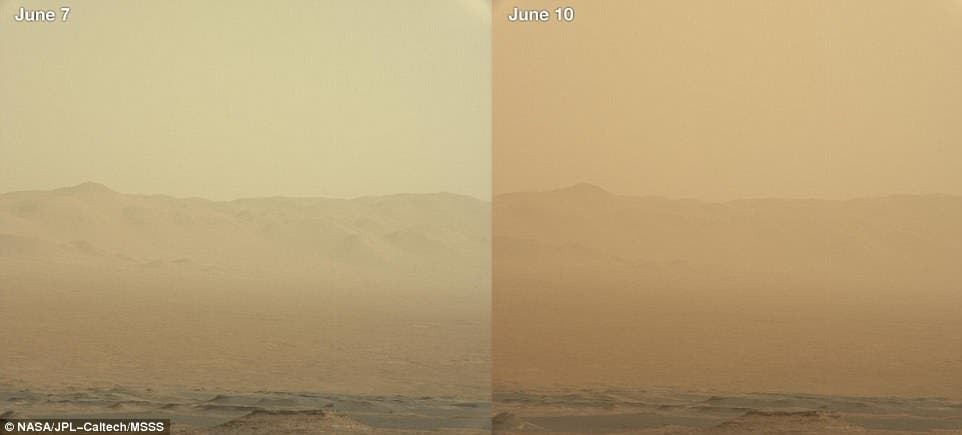NASA’s last contact with the Opportunity Rover took place over three weeks ago. Despite this, the agency believes it’s too early to assume the worst case scenario — the rover’s demise.

Image credits NASA / JPL.
We’ve been talking a lot about the huge dust storm that’s engulfed Mars of late, and of how NASA’s two rovers — Opportunity and Curiosity — are weathering the event. Out of the two, Curiosity has been served the much sweeter side of the dish: powered by a nuclear reactor and sitting out of the storm’s way, it’s been free to leisurely capture pics of the weather (and itself).
The older and solar-powered Opportunity, however, is stuck in the massive storm. Besides getting pelted by dust that may harm its scientific instruments, the rover is also unable to recharge. Dust blocks so much of the incoming sunlight that Opportunity’s solar panels just can’t create a spark. Bereft of battery charge, the rover stands a real chance of freezing to death on — fittingly– Mars’ Perseverance Valley.
Tough as old (ro)boots
Opportunity has been on duty for some 14 years now. It’s a veteran space explorer that relayed treasure troves of data for researchers back here on Earth. I’m rooting for the bot to weather the storm. By this point, however, it’s been three weeks since it last established contact with NASA — enough to make even the most resolute worry about its fate.
Dr. James Rice, co-investigator and geology team leader on NASA projects including Opportunity, says we shouldn’t assume the worst just yet.
Talking with Space Insider, Dr. Rice explains during its last contact with NASA, Opportunity also sent back a power reading. It showed the rover managed to scrape a meager 22 Wh of energy from its solar panels. For context, the rover managed to collect 645 Wh of energy from its panels just ten days before. This chokehold on energy is the NASA’s main concern at the moment.
However, he adds that the same storm which prevents Opportunity from recharging its batteries may ultimately also be its salvation.
One of the reasons NASA was caught offguard by the storm is that they simply don’t generally form around this time of the Martian Year. It’s currently spring on the Red Planet’s Southern Hemisphere, but dust storms usually form during summer. The only other dust event NASA recorded during the Martian Spring formed in 2001, and even that one came significantly later in the season than the current storm.

Still, at least it’s not winter — so average temperatures aren’t that low on Mars right now. The dust further helps keep Opportunity warmer, as it traps heat around the rover.
“We went from generating a healthy 645 watt-hours on June 1 to an unheard of, life-threatening, low just about one week later. Our last power reading on June 10 was only 22 watt hours the lowest we have ever seen” Dr. Rice explained.
“Our thermal experts think that we will stay above those low critical temperatures because we have a Warm Electronics Box (WEB) that is well insulated. So we are not expecting any thermal damage to the batteries or computer systems. Fortunately for us it is also the Martian Spring and the dust, while hindering our solar power in the day, helps keep us warmer at night,” he added.
The storm has reached 15.8 million square miles (41 million square kilometers) in size this June. It poses a real risk to Opportunity’s wellbeing, but ground control remains optimistic. Mars Exploration Program director Jim Watzin believes that the massive storm may have already peaked — but, considering that it took roughly a month for it to build up, it could take a “substantial” amount of time before it dissipates completely.
“As of our latest Opportunity status report Saturday (June 30) this storm shows no sign of abating anytime soon. We had a chance to conduct an uplink last night at the potential low-power fault window. We sent a real-time activate of a beep as we have done over the past two weeks. We had a negative detection of the beep at the expected time,” Dr Rice added.
“A formal listening strategy is in development for the next several months.”
Among all this, or rather also because of all that’s happening to Opportunity, I can’t help but feel genuine admiration for it as well as the people who helped put it together. Opportunity was first launched in 2004 and along its sister craft Spirit, was supposed to perform a 90-day mission. Spirit kept going until 2010, and Opportunity is still going strong today (and hopefully for longer). That’s a level of dedication I can only dream of.
Based in part on the rover’s rugged track record, Dr. Rice believes that “rumors of Opportunity’s death are very premature at this point.”


